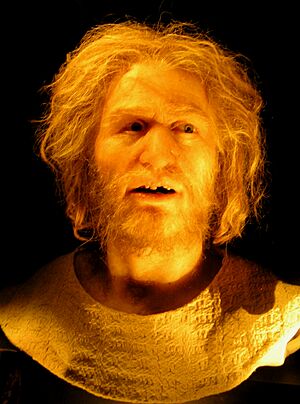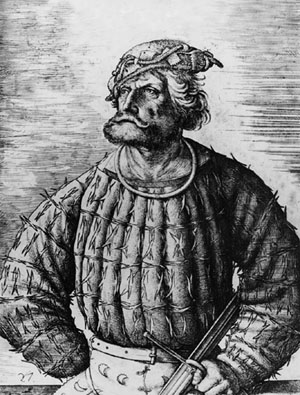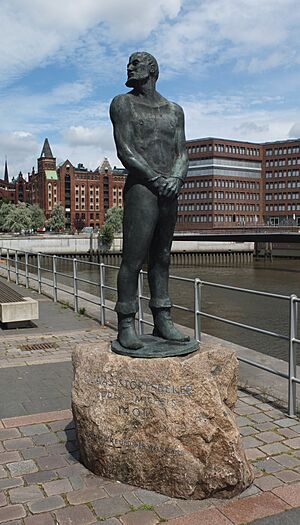Klaus Störtebeker facts for kids
Quick facts for kids
Störtebeker
|
|
|---|---|

Reconstruction of head from skull ascribed to Störtebeker
|
|
| Born | 1360 |
| Died | assumed 20 October 1401 (aged 40–41) assumed Hamburg
|
| Cause of death | execution by beheading |
| Other names | Storzenbecher |
| Occupation | merchant, privateer, violent entrepreneur |
| Years active | assumed 1392–1401 |
"Klaus" Störtebeker (born around 1360 – died around October 20, 1401) was a famous leader of a group of privateers. These privateers were like sea adventurers who sometimes worked for countries and sometimes for themselves. His group was known as the Victual Brothers.
The Victual Brothers were first hired during a war between Denmark and Sweden. Their job was to fight the Danish forces and bring food to the Swedish capital, Stockholm, which was under attack. After the war ended, they kept sailing the seas. They started capturing merchant ships for themselves. They called themselves "Likedeelers," which means "equal sharers," because they shared their loot equally.
Contents
Who Was Störtebeker?
Many stories and legends exist about Störtebeker's life. We don't know many exact facts. His name, "Störtebeker," was actually a nickname. It means "empty the mug with one gulp" in an old German language. This nickname came from a story that he could drink a huge mug of beer (about four liters) in one go! Back then, pirates often used cool nicknames instead of their real names.
Störtebeker was born in a port city called Wismar. People started hearing about him around 1398. This was after the Victual Brothers were forced to leave the island of Gotland in the Baltic Sea. They had set up a strong base there in the town of Visby.
In the years that followed, Störtebeker and other captains, like Gödeke Michels, became very active. They captured ships belonging to the Hanseatic League, which was a powerful group of trading cities. They didn't care where the ships came from.
Störtebeker also had a base on land in Marienhafe, in East Frisia. This was around 1396. There's even a tower named after him, the Störtebekerturm, which still stands today.
The Legend of Störtebeker
One of the most famous stories about Störtebeker tells of his capture. According to legend, in 1401, a fleet from Hamburg caught up with Störtebeker's ships near Heligoland. Some tales say a traitor helped the Hamburg fleet. This traitor supposedly poured hot lead into the chains that controlled Störtebeker's ship rudder, stopping it.
Störtebeker and his crew were captured and taken to Hamburg. There, they were put on trial for piracy. The legend says Störtebeker offered a huge amount of gold for his freedom. He offered a chain of gold long enough to go all the way around the city of Hamburg! But his offer was turned down.
Störtebeker and all 73 of his companions were sentenced to death. They were to be beheaded in a place called the Grasbrook.
The Walking Pirate
The most amazing legend about Störtebeker is about his execution. Störtebeker supposedly asked the mayor of Hamburg for a special favor. He asked that as many of his men as he could walk past after being beheaded should be set free. The mayor agreed to this strange request.
After Störtebeker was beheaded, his body reportedly stood up! It then walked past eleven of his men. But then, the executioner supposedly tripped him with his foot. Even though he walked past eleven men, all of them were still executed along with the others.
The city leaders of Hamburg then asked the executioner if he was tired after all that work. He famously replied that he could easily execute all of them too! Because of this bold answer, the executioner himself was sentenced to death. He was then executed by the youngest member of the city council.
Other Legends
Other stories say that when Störtebeker's ship was found, its masts were very special. They supposedly had cores made of gold, silver, and copper. This precious metal was then used to make the tip of St. Catherine's church in Hamburg.
His famous drinking mug was said to be kept in Hamburg's town hall. Sadly, it was destroyed in a big fire in 1842.
Some recent studies suggest that Störtebeker and his crew might have died in 1400, not 1401. This is based on old records that mention digging graves for 30 Victual Brothers in that year. However, the legends are still the most popular stories about him!
What Did He Look Like?
We don't have any real pictures of Störtebeker from his time. An old etching by a German artist was often thought to be him. But it's actually a picture of Kunz von der Rosen, who was a jester for an emperor.
However, scientists tried to guess what Störtebeker looked like. They used a skull that was believed to be his. This skull was on display in a museum. It was stolen in 2010 but thankfully found by the police in 2011.
Remembering Störtebeker
Störtebeker is still remembered today in many ways:
- You can find statues of him in several cities in Northern Germany. These include Hamburg, Verden an der Aller, and Marienhafe.
- The Störtebeker Festival (Störtebeker Festspiele) is a big outdoor theater show. It happens every year in Ralswiek on the island of Rügen. It tells the story of Störtebeker's life.
- The area around East Frisia is sometimes called Stoertebekerland to encourage tourism.
Störtebeker in Books and on TV
Störtebeker has appeared in many stories and shows:
- He is mentioned in some books by Estonian writer Indreg Hargla.
- He is also a character in the famous novel The Tin Drum by Gunter Grass.
- There have been several German novels about him, like Die Vitalienbrüder: Ein Störtebeker Roman.
- On television, Störtebeker was played by Ken Duken in a miniseries called Störtebeker in 2006.
- He was also the subject of a documentary and a movie called 12 Paces Without a Head.
- There's even a German brewery called Störtebeker Braumanufaktur. They chose their name to honor Störtebeker!




